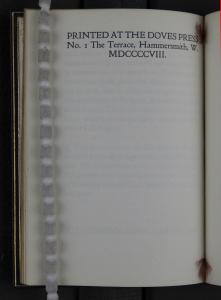

Credo
1. The complaint, and the consolation; or, Night thoughts
2. The Fables of Æesop, and others / With designs on wood, by Thomas Bewick
5. News from nowhere: or, An epoch of rest, being some chapters from Utopian romance
6. The nature of Gothic, a chapter of the stones of Venice
7. Daphnis and Chloe: a most sweet abd pleasant pastoral romance for young ladies
8. The Sphinx
10. Credo
14. Bible.Old Testament. Song of Solomon.
16. Kem byt’? / V. Maiï¸ a︡kovskiĭ ; ris. N. Shifrin.
17. The ghost in the underblows
19. Bateau ivre
-->
UCLA Call Number: Press Coll. Doves Annex

Credo

Credo

Credo

Credo
-->
Full title
Creator: Cobden–Sanderson,T.J. (Thomas James)
Publisher: Doves Press
Publication Place: Hammersmith
Date of Publication: 1908
Dimensions 17 cm
Physical Description:
The text is printed entirely in black ink with no variation. There are gilt edges on all pages. It is bound in blue morocco with gilt edges. Very light in hand and portable, the book is quite small and modest – one step above a pocketbook. The title, “CREDO” is gold–stamped unassumingly in small type on the spine and front cover. Where the blue morocco ends on the inside of the front and back cover, there are two thin parallel lines of gold trim. There are no images or illustrations anywhere in the book. The Doves Press watermark (two doves and the initials “C.S.” and “E.W.”) is very faintly visible on some pages, including the interior of the front cover. It appears as a half circle at the interior, center edge of the page.
Provenance: Unknown.Condition:
Overall, this copy is in very good condition. All pages are straight and clean. There is some wear and deterioration of the spine, but the binding remains intact.
Additional Info:
There are no images, designs or illustrations.
Interpretation:
If Cobden–Sanderson’s The Ideal Book established the Doves Press’ aesthetic and technical aspirations, then Credo is an evolved example of those objectives realized.
Credo is an excellent piece to examine alongside The Ideal Book. Printed eight years after its predecessor, Credo has a much more polished material presence. While The Ideal Book set out to define the artistic and technical merits of printing in the Arts & Crafts movement, Credo flaunts the possibilities of Cobden–Sanderson’s “Book Beautiful.” It demonstrates what Cobden–Sanderson believed a book could become when each of its elements was carefully constructed and designed to support the composite whole.
While the production quality of Credo feels more mature than the less sturdy Ideal Book, there is altogether a fascinating consistency in the style of Cobden–Sanderson’s printing between 1900 and 1908. The same fine restraint we see in The Ideal Book has been repeated in Credo. The reader is met with the signature Doves Type, printed exclusively in black ink and accompanied by no illustrations, borders or embellishments. The familiar Doves Press watermark is still visible; and where The Ideal Book was impressively organized with capitalized section headings and margin keys, Credo remains so with frequent line breaks and paragraph markers.
Compared, though, to The Ideal Book’s large and ragged pages, Credo is small, sturdy, clean, and contained – it is truly representative of the practical elegance for which the Doves Press books had come to be known. It is also worth mentioning that this is not a spatially economical work – while its size is less assuming than The Ideal Book’s, the number of blank pages far outnumbers the pages on which text appears. This is evidence of Cobden–Sanderson’s principles in action, and of everything that the fine presses of the Arts & Crafts movement championed in the art of bookbinding. As Morris, Cobden–Sanderson and others believed, books were not (or should not be) brought into existence merely to disseminate content to an audience; they were to be understood and introduced into the world as well–crafted works of art. The text itself – in this case Cobden–Sanderson’s reflections on life, death and man’s place in the universe – was seen as only one of many elements in service of the composite whole. The blank pages remind us that the work of the “Book Beautiful” expands beyond the mere text, and it is clear that Cobden–Sanderson conceived of Credo as a showcase for this conviction.
Text Content Description:
A very brief tract spanning only four pages, Credo is a series of short poetic statements (most beginning with “I believe”) summarizing the author’s metaphysical convictions regarding life and death and mankind’s place in the universe. For example, he writes: “I believe and I see that as the earth turns upon itself we pass into the light and wake to life & die downward into darkness and the sleep of rest, and that we are one in life and sleep with the earth's self… ”
Contributor: Margarita Howell